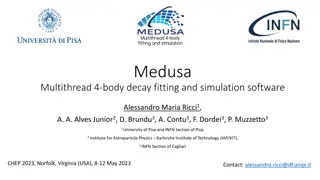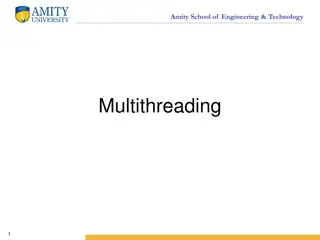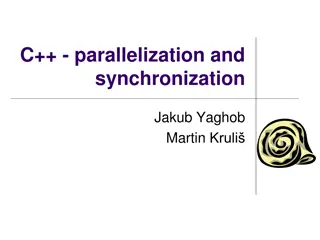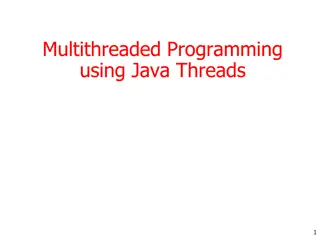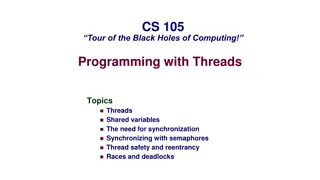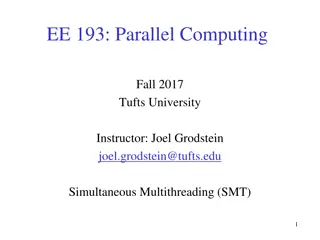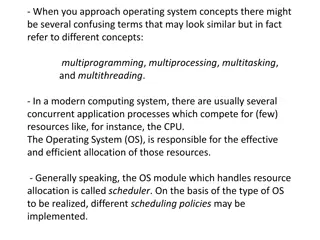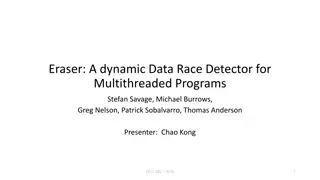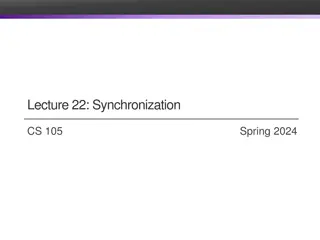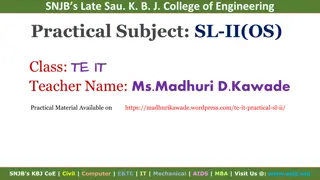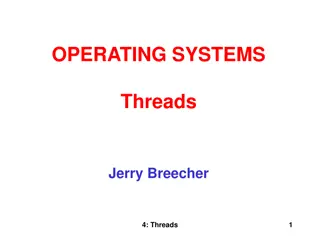
Multithreading and Parallelism in Computer Science
Explore the impact of removing the sequential programming assumption, challenges, and opportunities in programming, algorithms, and data structures. Delve into the evolution of multithreading, the difficulty of writing multithreaded code, and the shift towards leveraging multiple processors for improved performance and efficiency in modern computing.
Download Presentation

Please find below an Image/Link to download the presentation.
The content on the website is provided AS IS for your information and personal use only. It may not be sold, licensed, or shared on other websites without obtaining consent from the author. If you encounter any issues during the download, it is possible that the publisher has removed the file from their server.
You are allowed to download the files provided on this website for personal or commercial use, subject to the condition that they are used lawfully. All files are the property of their respective owners.
The content on the website is provided AS IS for your information and personal use only. It may not be sold, licensed, or shared on other websites without obtaining consent from the author.
E N D
Presentation Transcript
CSE 332 Data Structures & Parallelism Introduction to Multithreading & Fork-Join Parallelism Melissa Winstanley Spring 2024
Updates Project 2 due THURSDAY Up to 2 late days available Project 3 will be released on Thursday as well Ex7 Sorting due TOMORROW Ex8 Dijkstra s due next Tuesday Regrade requests open for the midterm
Changing a major assumption So far most or all of your study of computer science has assumed One thing happened at a time Called sequential programming everything part of one sequence Removing this assumption creates major challenges & opportunities - Programming: Divide work among threads of execution and coordinate (synchronize) among them Algorithms: How can parallel activity provide speed-up (more throughput: work done per unit time) Data structures: May need to support concurrent access (multiple threads operating on data at the same time) - -
How did we get here? Writing correct and efficient multithreaded code is often much more difficult than for single-threaded (i.e., sequential) code - - Especially in common languages like Java and C So typically stay sequential if possible From roughly 1980-2005, desktop computers got exponentially faster at running sequential programs - About twice as fast every couple years But nobody knows how to continue this - - - Increasing clock rate generates too much heat Relative cost of memory access is too high But we can keep making wires exponentially smaller (Moore s Law ), so put multiple processors on the same chip ( multicore )
What to do with multiple processors? Your computer and phone probably have at least 4-8 processors - - Wait a few years and it will be 16, 32, The chip companies have decided to do this (not a law ) What can you do with them? - Run multiple totally different programs at the same time - Already do that? Yes, but with time-slicing Do multiple things at once in one program - Our focus more difficult - Requires rethinking everything from asymptotic complexity to how to implement data-structure operations -
Parallelism vs. Concurrency Note: Terms not yet standard but the perspective is essential - Many programmers confuse these concepts Parallelism: Concurrency: Use extra resources to solve a problem faster efficiently manage work Correctly and requests access to shared resources resources resource There is some connection: - Common to use threads for both If parallel computations need access to shared resources, then the concurrency needs to be
An analogy A program is like a recipe for a cook - One cook who does one thing at a time! (Sequential) Parallelism: (Let s get the job done faster!) - - - Have lots of potatoes to slice? Hire helpers, hand out potatoes and knives But too many chefs and you spend all your time coordinating Concurrency: (We need to manage a shared resource) - - Lots of cooks making different things, but only 4 stove burners Want to allow access to all 4 burners, but not cause spills or incorrect burner settings
Pseudocode for array sum: (note FORALL doesn t exist) Parallelism Example int sum(int[] arr){ res = new int[4]; len = arr.length; FORALL(i=0; i < 4; i++) { //parallel iterations res[i] = sumRange(arr,i*len/4,(i+1)*len/4); } return res[0]+res[1]+res[2]+res[3]; } int sumRange(int[] arr, int lo, int hi) { result = 0; for(j=lo; j < hi; j++) result += arr[j]; return result; }
Pseudocode for a hashtable: Concurrency Example class Hashtable<K,V> { void insert(K key, V value) { int bucket = ; prevent-other-inserts/lookups in table[bucket] do the insertion re-enable access to table[bucket] } V lookup(K key) { (similar to insert, but can allow concurrent lookups to same bucket) } }
Shared Memory with Threads The model we will assume is shared memory with explicit threads Old story: A running program has - - - One program counter (current statement executing) One call stack (with each stack frame holding local variables) Objects in the heap created by memory allocation (i.e., new) - (nothing to do with data structure called a heap) Static fields - New story: - A set of threads, each with its own program counter & call stack - No access to another thread s local variables Threads can (implicitly) share static fields / objects - To communicate, write values to some shared location that another thread reads from -
Other models We will focus on shared memory, but you should know several other models exist and have their own advantages Message-passing: Each thread has its own collection of objects. Communication is via explicitly sending/receiving messages Cooks working in separate kitchens, mail around ingredients Dataflow: Programmers write programs in terms of a DAG. A node executes after all of its predecessors in the graph Cooks wait to be handed results of previous steps Data parallelism: Have primitives for things like apply function to every element of an array in parallel
Our needs To write a shared-memory parallel program, need new primitives from a programming language or library Ways to create and run multiple things at once Let s call these things threads Ways for threads to share memory Often just have threads with references to the same objects Ways for threads to coordinate (a.k.a. synchronize) For now, a way for one thread to wait for another to finish Other primitives when we study concurrency
Java Basics First learn some basics built into Java via java.lang.Thread Then a better library for parallel programming To get a new thread running: 1. Define a subclass C of java.lang.Thread, overriding run 2. Create an object of class C 3. Call that object s start method start sets off a new thread, using run as its main What if we instead called the run method of C? This would just be a normal method call, in the current thread Let s see how to share memory and coordinate via an example
Parallelism idea Example: Sum elements of a large array Idea: Have 4 threads simultaneously sum 1/4 of the array - Warning: This is an inferior first approach - - - - Create 4 thread objects, each given a portion of the work Call start() on each thread object to actually run it in parallel Wait for threads to finish using join() Add together their 4 answers for the final result
First Attempt, Part 1 class SumThread extends java.lang.Thread { int lo; // fields, assigned in the constructor int hi; // so threads know what to do. int[] arr; int ans = 0; // result - field used to communicate // across threads SumThread(int[] a, int l, int h) { lo=l; hi=h; arr=a; } public void run() { //override must have this type for(int i=lo; i < hi; i++) ans += arr[i]; } }
First attempt, continued (wrong) class SumThread extends java.lang.Thread { ... } int sum(int[] arr){ // can be a static method int len = arr.length; int ans = 0; SumThread[] ts = new SumThread[4]; for(int i=0; i < 4; i++) // do parallel computations ts[i] = new SumThread(arr,i*len/4,(i+1)*len/4); for(int i=0; i < 4; i++) // combine results ans += ts[i].ans; return ans; }
Second attempt (still wrong) class SumThread extends java.lang.Thread { ... } int sum(int[] arr){ // can be a static method int len = arr.length; int ans = 0; SumThread[] ts = new SumThread[4]; for(int i=0; i < 4; i++) { // do parallel computations ts[i] = new SumThread(arr,i*len/4,(i+1)*len/4); ts[i].start(); // start not run } for(int i=0; i < 4; i++) // combine results ans += ts[i].ans; return ans; }
Third attempt (correct in spirit) fork join int sum(int[] arr){ // can be a static method int len = arr.length; int ans = 0; SumThread[] ts = new SumThread[4]; for(int i=0; i < 4; i++) { // do parallel computations ts[i] = new SumThread(arr,i*len/4,(i+1)*len/4); ts[i].start(); } for(int i=0; i < 4; i++) { // combine results ans += ts[i].ans; ts[i].join(); // wait for helper to finish! } return ans; }
Fourth attempt (better!) int sum(int[] arr, int numTs) { // parameterize by # of threads int len = arr.length; int ans = 0; SumThread[] ts = new SumThread[numTs]; for(int i=0; i < numTs; i++) { ts[i] = new SumThread(arr,i*len/numTs,(i+1)*len/numTs); ts[i].start(); } for(int i=0; i < numTs; i++) { ans += ts[i].ans; ts[i].join(); } return ans; }
(think of a unit of work as 1 second) Problem 1: processors available to ME 24 units of work If 1 of those 4 processors is busy with other work If we had optimally distributed work 4 processors One unit of work has to wait - twice as long! 6 units of work per processor 8 units of work per processor
Problem 2: unequal work For some problems, dividing the array equally may result in subproblems that take significantly different amounts of time. Very small numbers Very big numbers isPrime() = 10 sec isPrime() = 15 sec isPrime() = 30 sec isPrime() = 50 sec
Solution attempt #1 The counterintuitive (?) solution to all these problems is to cut up our problem into many pieces, far more than the number of processors - - But this will require changing our algorithm And for constant-factor reasons, abandoning Java s threads ... N 1. Forward-portable: Lots of helpers each doing a small piece 2. Processors available: Hand out work chunks as you go 3. Load imbalance: No problem if slow thread scheduled early enough - Variation probably small anyway if pieces of work are small
BUT naive algorithm is poor int sum(int[] arr) { int numThreads = arr.length / 1000; SumThread[] ts = new SumThread[numThreads]; ... } Suppose we create 1 thread to process every 1000 elements Then the combining of results part of the code will have arr.length / 1000 additions Linear in size of array (with constant factor 1/1000) Previously we had only 4 pieces ( (1) to combine) In the extreme, suppose we create one thread per element If we use a for loop to combine the results, we have N iterations In either case we get a (N) algorithm with the combining of results as the bottleneck .
A better idea: Divide and Conquer! 1) Divide problem into pieces recursively: - - Start with full problem at root Halve and make new thread until size is at some cutoff 2) Combine answers in pairs as we return from recursion (see diagram)
A better idea: Divide and Conquer! This will start small, and grow threads to fit the problem. This is straightforward to implement using divide-and-conquer. - Parallelism for the recursive calls
Divide & conquer Create threads O(log n) Create threads O(n) Threads doing work Threads doing work Join & combine O(n) Join & combine O(log n) O(n) Sequential program (no parallelism) Naive approach (use loops to create threads) Divide & conquer
Fifth attempt (still using Java Threads) class SumThread extends java.lang.Thread { int lo; int hi; int[] arr; int ans = 0; // result SumThread(int[] a, int l, int h) { ... } public void run() { // override if(hi lo < SEQUENTIAL_CUTOFF) for(int i=lo; i < hi; i++) ans += arr[i]; else { SumThread left = new SumThread(arr,lo,(hi+lo)/2); SumThread right = new SumThread(arr,(hi+lo)/2,hi); left.start(); right.start(); left.join(); // don t move this up a line why? right.join(); ans = left.ans + right.ans; } } } int sum(int[] arr){ // just make one thread! SumThread t = new SumThread(arr,0,arr.length); t.run(); return t.ans; }
Being realistic In theory, you can divide down to single elements, do all your result-combining in parallel and get optimal speedup - Total time O(n / numProcessors + log n) In practice, creating all those threads and communicating swamps the savings, so do two things to help: 1. Use a sequential cutoff, typically around 500-1000 - Eliminates almost all the recursive thread creation (bottom levels of tree) - Exactly like quicksort switching to insertion sort for small subproblems, but more important here 1. Do not create two recursive threads; create one thread and do the other piece of work yourself - Cuts the number of threads created by another 2x
order of last 4 lines is critical why? Half the threads! // wasteful, don t SumThread left = SumThread right = left.start(); right.start(); left.join(); right.join(); ans=left.ans+right.ans; // better, do! SumThread left = SumThread right = left.start(); right.run(); // normal function call! left.join(); // no right.join needed ans=left.ans+right.ans; If a language had built-in support for fork-join parallelism, I would expect this hand-optimization to be unnecessary But the library we are using expects you to do it yourself And the difference is surprisingly substantial Again, no difference in theory
That library, finally Even with all this care, Java s threads are too heavyweight Constant factors, especially space overhead Creating 20,000 Java threads just a bad idea The ForkJoin Framework is designed to meet the needs of divide-and-conquer fork-join parallelism In the Java 8 standard libraries Section will focus on pragmatics/logistics Similar libraries available for other languages C/C++: Cilk (inventors), Intel s Thread Building Blocks C#: Task Parallel Library Library s implementation is a fascinating but advanced topic
Different terms, same basic idea To use the ForkJoin Framework: A little standard set-up code (e.g., create a ForkJoinPool) Java Threads: Framework: ForkJoin Do subclass Don t subclass Thread RecursiveTask<V> Don t override run override compute Do not use an ans field from compute Don t call start Do Do return a V Do call
ForkJoin Framework Version (missing imports) class SumTask extends RecursiveTask<Integer> { int lo; int hi; int[] arr; SumTask(int[] a, int l, int h) { ... } protected Integer compute() { // override if(hi lo < SEQUENTIAL_CUTOFF) int ans = 0; // not a field for(int i=lo; i < hi; i++) ans += arr[i]; return ans; else { SumTask left = new SumTask(arr,lo,(hi+lo)/2); SumTask right = new SumTask(arr,(hi+lo)/2,hi); left.fork(); // forks a thread and calls compute int rightAns = right.compute(); // call directly int leftAns = left.join(); // get result from left return leftAns + rightAns; } } static final ForkJoinPool POOL = new ForkJoinPool(); int sum(int[] arr){ SumTask task = new SumTask(arr,0,arr.length) return POOL.invoke(task); // invoke returns the value }
Getting good results in practice Sequential threshold - Library documentation recommends doing approximately 100-5000 basic operations in each piece of your algorithm Library needs to warm up - May see slow results before the Java virtual machine re-optimizes the library internals - Put your computations in a loop to see the long-term benefit

